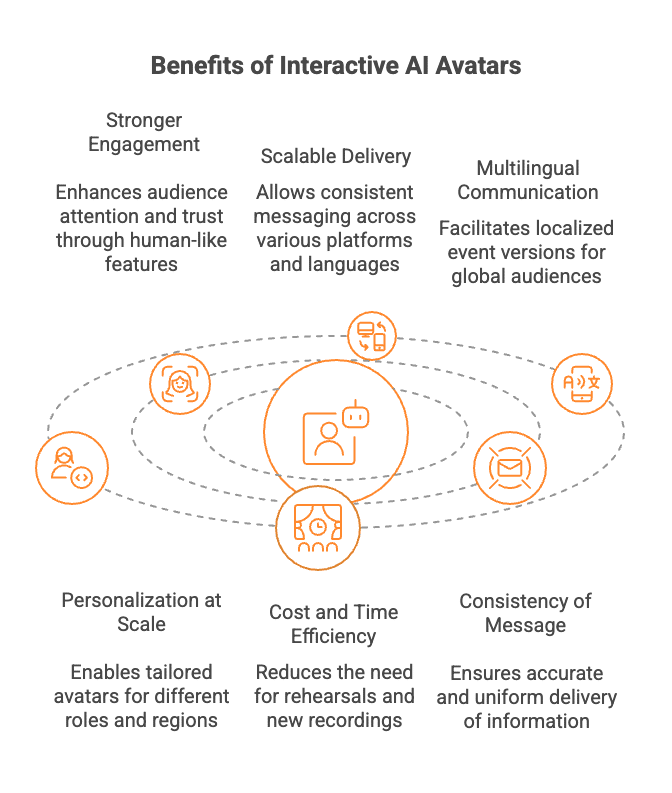Why Virtual Event Avatars Are Changing the Way We Host Webinars

Key Takeaways:
- Virtual event avatars create a more human, memorable experience for online audiences.
- Interactive AI avatars increase engagement, consistency, and personalization in webinars.
- D-ID offers tools that simplify avatar creation, localization, and live or recorded delivery.
The way we run webinars and virtual events is shifting. Attention spans are shorter, audiences expect more than slide decks, and brands need new ways to stand out. Virtual event avatars have emerged as a fresh solution that gives webinars a face.
These AI-powered digital presenters serve as the “human” element in a digital room. Rather than relying solely on text, slides, or faceless voiceovers, event hosts can now deploy virtual presenters who speak directly to the audience. These avatars can be customized to look professional, friendly, authoritative, or playful, depending on your brand and your message.
They’re especially effective in hybrid events where part of the audience is attending in person and others are joining remotely. In these cases, avatars help bridge the gap and provide a consistent presence across environments. You can use the same avatar to open a livestreamed keynote, guide online attendees through a breakout session, or deliver a post-event follow-up message on demand.
Enterprises across industries are turning to virtual event avatars to personalize the experience, make messaging more consistent, and scale presentations globally. Whether it’s a product launch or an onboarding session, avatars are giving content a face and providing audiences with a reason to stay tuned.
What Are the Key Benefits of Using AI Avatars in Virtual Events
AI avatars offer more than novelty. For enterprise teams, they unlock real business value by enhancing communication and reducing friction across global audiences.
Here are the key benefits of using interactive AI avatars:
1. Stronger Engagement
Audiences are more likely to retain information when it is presented by a human-like avatar. Facial expressions, voice intonation, and body language help build trust and hold attention.
2. Scalable Delivery
Avatars can be reused across teams, departments, and time zones. Once created, the same avatar can deliver consistent messaging across multiple events or languages without needing to be re-recorded.
3. Multilingual Communication
Virtual event avatars, built with multilingual support, allow enterprises to deliver localized versions of their events. This is especially useful for global product demos or international internal meetings.
4. Personalization at Scale
With tools like D-ID’s Express Avatars, businesses can quickly generate avatars tailored to each department, role, or region without hiring additional presenters.
5. Cost and Time Efficiency
Once an avatar is set up, it can be used repeatedly. There’s no need to schedule rehearsals, record new footage, or worry about presenter availability.
6. Consistency of Message
Human presenters may drift off-script, forget key points, or present slightly differently each time. Avatars deliver exactly what was intended, every time.
When combined with an engaging script and a visually polished backdrop, avatars bring a professional tone to any online presentation, making virtual events feel more personal and dynamic.

Another major advantage is accessibility. By combining avatars with captions, sign language overlays, or translated audio, you can make your presentations more inclusive to people with different needs and backgrounds. This is especially valuable for organizations hosting public-facing webinars, governmental briefings, or educational content.
Virtual event avatars also help democratize the delivery of presentations. Not every team has experienced public speakers. With avatars, marketing, product, or HR teams can turn their key ideas into polished video messages without worrying about stage presence, accent, or availability.
This levels the playing field across internal roles and enables more people to contribute effectively to external-facing content.
How to Implement Interactive AI Avatars in Webinars
Introducing an avatar to your next virtual event does not need to be complicated. With a few smart decisions and the right tools, you can quickly go from static slides to a dynamic avatar-led experience.
Step 1: Select the Right Avatar Style
There are several types of avatars available: from photorealistic, professional-looking presenters to more stylized or branded figures. Choose one that aligns with your brand’s tone and your event goals. For enterprise use, photoreal avatars are often preferred for credibility and relatability.
Step 2: Create and Upload Your Knowledge Base
Once you’ve chosen an avatar, you’ll need to educate them on your product, your industry, and your company. This could include an employee guidebook, text from your website, sales decks, and other relevant materials. Ensure that you are clear and consistent with the tone and messaging in your knowledge base, so that your avatar truly reflects your company’s values. For pre-recorded avatars, write your script and make sure it aligns with the needs of your event. What message are you trying to convey?
Step 3: Choose Voice and Language Options
The voice can make or break the experience. Tools like D-ID let you select from a range of synthetic voices or even clone your own. Multilingual capabilities allow you to create localized versions that resonate with each region.
Step 4: Integrate With Your Webinar Platform
Export your avatar videos in a format supported by platforms like Zoom, Microsoft Teams, or your preferred webinar software. For live events, you can even prepare avatar videos for transitions, intros, and wrap-ups.
Step 5: Track Viewer Interaction and Feedback
Post-event analysis is crucial. Use analytics tools to measure how long viewers stayed, where they clicked, and whether engagement improved compared to previous, avatar-free events. One tip to increase impact is to pair your avatar with visual transitions. For instance, if you’re delivering a product tutorial, you can intersperse avatar-led explanations with screenshots, live product demos, or short animations. This keeps viewers focused and helps clarify complex ideas.
Another best practice is versioning. Consider creating multiple versions of your avatar video: one for external customers, one for internal employees, and one for partners. D-ID’s tools make it easy to repurpose the same core script for different use cases, cutting down production time while increasing output.
Over time, you can optimize the content and avatar style based on performance data.
D-ID’s Role in Powering Interactive Avatars for Virtual Events
D-ID provides an end-to-end solution for creating and scaling virtual event avatars across industries. Our tools allow enterprises to build avatars quickly, modify them for different languages, and embed them into any digital presentation.
Here’s how D-ID stands out:

- AI Visual Agents: Generate a talking and interactive avatar from a high-quality video, complete with synchronized facial movement and voice.
- Creative Reality Studio: Access advanced customization features including video scripting, voice cloning, and integration with existing video workflows.
- Multilingual Support: Translate scripts and automatically sync voice and lips for international viewers.
- Seamless Export: Embed your avatar in training decks, product demos, or live sessions with ease.
- AI Agent Framework: Go beyond passive avatars with AI Agents that can answer questions and guide audiences interactively.
You can also use avatars in asynchronous video series. Many enterprises are now building knowledge hubs where avatars deliver short, focused updates or product news that users can watch at any time. This lets you extend the life of your event content far beyond a one-time live session.
For highly regulated industries, avatars allow for exact control over messaging. Financial services firms, for example, use avatars to ensure compliance-approved explanations are delivered the same way every time, no deviation, no risk.
By combining avatar creation with real-time analytics, companies can also test which messages resonate most. If one version of your avatar has a higher retention rate or click-through rate, you can double down on what works, something that’s far harder with live presenters.
You can also explore how others are using our avatars in customer experience workflows and see what’s possible when your event content has a face and a voice.
Next Steps: Give Your Virtual Events a Human Touch
Adding a virtual event avatar to your webinar is more than a visual upgrade. It’s a strategic way to increase connection, reduce friction, and communicate consistently at scale.
With D-ID, you can:
- Create interactive avatars in minutes
- Localize content for global audiences
- Embed avatars into any webinar platform
- Explore AI agents for real-time interactivity
If you’re ready to see how it works, book an intro call or start creating with our Express Avatars and Creative Studio. Virtual events with avatars are already helping enterprises stand out. Now it’s your turn.
Visual Agent FAQs
-
A virtual event avatar is an AI-generated character that serves as a presenter in digital events. It can deliver scripts using synthesized speech, display human-like expressions, and appear on screen in place of a real speaker. These avatars are created using tools like D-ID’s Express Avatars or Creative Studio, where users can upload a photo and script. Once generated, the avatar can be exported into any video or webinar software for seamless integration.
-
Virtual event avatars help keep audiences engaged by offering a face and voice to the message. Human-like interaction creates visual interest and mimics the experience of watching a live presenter. This makes it easier for viewers to connect with the content and stay focused longer. Avatars also offer consistent delivery, which can help with information retention. Combined with interactivity and localization, they provide a more immersive experience than slides alone.
-
Yes, virtual event avatars are fully customizable to fit industry-specific needs. Whether you’re in healthcare, finance, education, or tech, avatars can be tailored to match your audience’s expectations. You can choose how they look, how they sound, what language they speak, and even how formal or casual they present. This flexibility makes avatars suitable for both internal communications and external-facing content across multiple sectors.
-
D-ID offers a comprehensive suite of tools for creating and deploying avatars. With Express Avatars, companies can create avatars from recorded video and a script. The Creative Reality Studio offers advanced control over language, tone, and avatar behavior. D-ID also provides multilingual capabilities, making it easier for enterprises to host events across different regions without duplicating effort or resources.
-
Best practices include writing a clear and concise script tailored to your target audience, selecting a voice that aligns with your brand, and testing avatar performance before a live session. It’s also helpful to include supporting visuals, such as product demos or graphics, to accompany the avatar. Using analytics post-event can help refine your approach. Ensure the avatar’s tone, style, and delivery align with your goals, whether that’s selling, educating, or training.
Was this post useful?
Thank you for your feedback!
 Libi Michelson
Libi Michelson